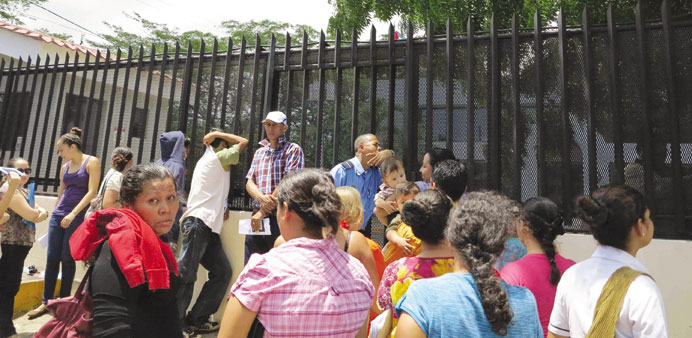A small crowd gathering outside the consulate of Costa Rica in Nicaragua’s capital, Managua. Most weekdays see scores of Nicaraguans seeking a Costa Rican visa. Costa Rica is like the US to Nicaraguans, according to acclaimed writer Sergio Ramirez.
Nicaragua is the second-poorest country in the Western Hemisphere and, like its Central American neighbours, a transhipment point for cocaine headed to the US.
But unlike El Salvador, Honduras and Guatemala to the north, Nicaragua hasn’t sent a wave of children and teenagers fleeing north. Of the 62,998 unaccompanied children who’ve been detained at the US border between October 1 and the end of July, only 194 have been Nicaraguan, according to US Customs and Border Protection figures.
The reason? In part, it’s because while Nicaragua is poor, it’s also the safest country in Central America.
Nicaragua’s homicide rate is slightly lower than neighbouring Costa Rica, a nation known as the Switzerland of Central America. Vicious transnational street gangs that have overwhelmed police forces elsewhere have no presence in Nicaragua.
Experts looking for why point to a national police force widely seen as more engaged with the citizenry - perhaps too much so, some might argue - than its counterparts elsewhere.
They also point to a migration pattern different from that found in countries to the north.
While Nicaraguans fled their homeland for the US during the 1979-1990 Sandinista Revolution, they primarily settled in South Florida, where they were embraced by that region’s Cuban-Americans, who saw them as kindred refugees from communism, and where gangs such Los Angeles’ notorious 18th Street weren’t active.
Today Nicaraguans seeking opportunity are more likely to travel south, toward Costa Rica and Panama, than to make the dangerous and expensive journey north.
Sandinista President Daniel Ortega, a former leftist revolutionary who now leads an authoritarian pro-business government, takes pride in the low crime.
“We have the satisfaction, the blessing, the privilege of being one of the safest countries - I dare say - in the world,” Ortega’s wife and spokeswoman, Rosario Murillo, told the nation in a talk April 9.
There’s virtually no extortion in Nicaragua from criminal gangs of the kind rampant in the Central American nations to the north, and crime syndicates have failed to permeate law enforcement and the military.
According to the US State Department’s 2014 drug enforcement report, the amount of cocaine transiting Nicaragua fell last year, from 9.7 tons seized in 2011 and 10.2 tons seized in 2012 to 3.3 tons in 2013.
Visiting industrialists from the Northern Triangle, as El Salvador, Guatemala and Honduras are known, seem to breathe easier in Nicaragua.
“They come here driving their own cars. In their countries, they go around in armoured cars and with guards. Here, they feel free. They feel they are in a different world,” said Jose Adan Aguerri, head of the Private Enterprise Council, or COSEP, Nicaragua’s umbrella association of business chambers.
Earlier this year, the UN Development Programme reported that Nicaragua’s homicide rate had dropped to 8.7 per 100,000 inhabitants, below the 10.3 rate in Costa Rica, a nation that abolished its army in 1948 and has become a beacon of neutrality.
Honduras, which tallies 92 homicides per 100,000 inhabitants, has the highest murder rate in the world. El Salvador’s is 69 per 100,000 residents and Guatemala’s 39 per 100,000.
Nicaraguan officials credit a community-oriented style of policing that puts officers on beats across the country, talking constantly with the citizenry.
With their sky-blue uniforms, police are a common sight knocking on doors of private homes. Fully 43% of the force is female, said Juan Pablo Gordillo, a citizen security specialist with the UN Development Programme.
“You see it day by day. One or two police officers going door to door just to visit, asking about the situation in the neighborhood,” Gordillo said.
The questions are friendly but inquisitive, with an eye out for youngsters.
Gordillo said surveys show that seven out of 10 minors at risk of falling into crime or drug abuse in Nicaragua are pulled into government programs for sports, vocational training or music, thwarting a move toward gang activity.
But not all analysts see Nicaragua’s National Police as the solution, even as proselytizers of its model of community-based preventative policing have taken the model to Bolivia, Venezuela and other countries.
Monica Zalaquett, director of the Centre for the Prevention of Violence, fretted that groups that work directly with at-risk youth are facing new pressures from the Sandinista government, including funding cuts from foreign donors afraid to cross Ortega and his wife.
“They keep shutting the doors on civil society,” Zalaquett said, noting what a program officer heard at a recent neighbourhood meeting.
“She said the political chiefs of the barrio said I could keep working with you but I have to tell them everything,” Zalaquett recalled.
Another reason Nicaraguans, both children and adults, are not heading in great numbers toward the US is that they are more inclined to look south.
Nicaragua’s per capita economic output is $1,831 annually, compared with Costa Rica’s $10,528, according to Nicaragua’s central bank, meaning standards of living are five times higher across the southern border. Nicaragua is considered the second-poorest nation in the Western Hemisphere after Haiti.
On any given day, far more would-be emigrants are crowded outside the Costa Rican consulate in Managua than the US consulate.
“There are always huge lines here,” said Jose Alberto Fernandez, a vendor of bus tickets to would-be immigrants emerging from the Costa Rican consulate. “People come here on Sunday nights and spend the night” to be first in line on Mondays.
Nicaraguans make up 12% of Costa Rica’s workforce, according to that nation’s census institute, mostly in agriculture, construction and services. At times of coffee and sugar cane harvesting, the official estimate of resident Nicaraguans at 287,766 is widely considered to swell to half a million.
“Costa Rica is like the US to Nicaraguans. Our very own ‘American dream’ right there, right next door,” acclaimed writer Sergio Ramirez, who served as vice president under Ortega from 1985 to 1990, wrote recently in a Huffington Post essay.
To understand why so few Nicaraguan children reach the US border, Ramirez wrote, one must first see that “their parents are not in Chicago, Newark or Los Angeles. ... They are in Costa Rica.”



